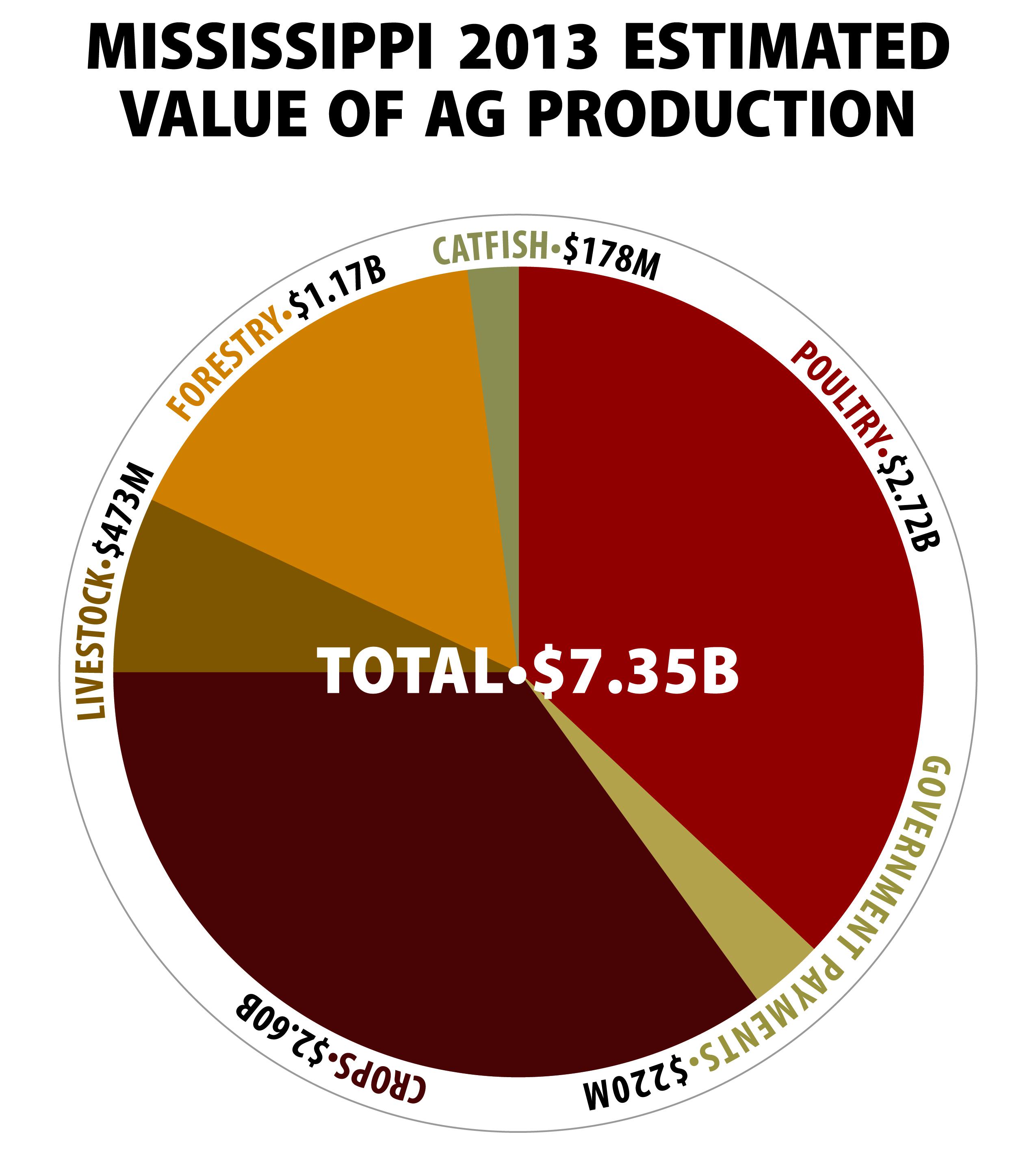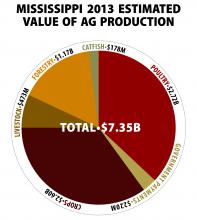Information Possibly Outdated
The information presented on this page was originally released on December 19, 2013. It may not be outdated, but please search our site for more current information. If you plan to quote or reference this information in a publication, please check with the Extension specialist or author before proceeding.
Strong production cannot overcome lower ag prices
MISSISSIPPI STATE -- Mississippi’s top two agricultural commodities -- poultry and forestry -- maintained their strength in 2013, but most agronomic crop values took a hit from significantly lower prices than those earned in 2012.
John Michael Riley, agricultural economist with the Mississippi State University Extension Service, said agronomic crop prices were a major drag in the state’s total agricultural commodity value despite good-to-great production levels.
“In 2012, when most of the nation’s farmland was experiencing a major drought, Mississippi farmers were able to produce very good yields,” he said. “While yields were down across the country, our growers were able to capitalize on the higher prices.”
For perspective, Riley has charted out estimated agricultural commodity values for 2013 compared to the previous year and the five-year average. The estimated $7.35 billion is 4 percent less than 2012’s total value, but 11 percent more than the five-year average.
Poultry and forestry…
“The total decline in value would have been greater if poultry and forestry had not showed as much improvement from one year to the next,” he said. “2012 was more of an anomaly with respect to crops.”
Poultry, the state’s No. 1 agricultural commodity, is estimated at $2.7 billion, which is 10 percent more than in 2012 and 13 percent more than the five-year average. Forestry, the state’s No. 2 crop, is valued at $1.17 billion, an increase of almost 15 percent from 2012 and 17 percent above the five-year average.
Perspective…
“The five-year average is also a good gauge of the industries that are on the rise as well as those that are declining,” he said.
Riley said drastic differences from one year to the next can be due to factors out of the control of industry participants, especially in agricultural production.
“Comparisons to the five-year average provide better context with respect to an industry’s general direction, as can be seen in values for the state’s No. 3 and 4 crops: soybeans and corn,” he said.
The soybean value is estimated at $993 million, down 21 percent from 2012 but up 14 percent on the five-year average. Soybean yields averaged 43 bushels per acre, just below the previous year’s record of 45 bushels per acre. Corn, which set a new record with 180 bushels per acre, has an estimated value of $631 million, down 31 percent from 2012 but up 18 percent on the five-year average.
Some of the biggest value reductions over the last five years include a 26 percent decline in rice, a 21 percent decline in cotton lint and a 12 percent decline in catfish. In addition to poultry, forestry and corn, the largest trending increases in the state’s main crops include 30 percent in livestock and 25 percent in hay.
Rice…
Tim Walker, rice specialist at MSU’s Delta Research and Extension Center in Stoneville, said Mississippi growers started reducing their acreage from the 20-year average in 2011, but 2013 was an excellent year for rice. The rice value estimate was $141 million.
“Growers planted just a few thousand acres less than the year before, but our final average yields should be a state record,” he said. “2012’s average was 7,200 pounds per acre, and we should have at least 7,500 pounds per acre in 2013. We are down significantly on the five-year average value because of how many more acres we used to plant. In recent years, we have planted about 50 percent of the typical acreage.”
Walker said two strong years will motivate growers to expand rice acres in 2014. Mississippi farmers could plant nearly 200,000 acres in rice, compared with 130,000 acres in 2013.
Cotton…
Another crop expected to post record yields in 2013 and gain ground in 2014 is cotton. Each positive factor comes after years of reduced acres. Mississippi growers planted nearly a million or significantly more acres of cotton each year until 2007. In 2013, the state harvested 295,000 acres. Cotton lint was estimated at about $262 million and cotton seed at about $69 million, for a total value of $331 million.
“We just harvested 1,188 pounds of cotton per acre, beating our previous yield record of 1,024 pounds per acre in 2004,” said Darrin Dodds, Extension cotton specialist.
“We got a late start with a long, cold and wet spring, but then the weather provided just what the crop needed,” he said. “It was warm during the summer but not oppressively hot, especially at night. The hottest weeks of the year were late in the summer when it needed to finish out the late crop. We also got some timely rains.”
Catfish…
Jimmy Avery, Extension aquaculture specialist and director of the Southern Regional Aquaculture Center in Stoneville, said U.S. catfish processing numbers are projected to be up about 10 percent from 2012. This is the first significant increase in production since 2002. He said the recent trend of reducing pond acreage appears to be near its conclusion.
“We lost about 2,600 acres from 2012 to 2013. Most of those ponds were used for fingerlings, leaving a larger percentage of food fish acreage for 2013,” he said. “That change could eventually result in a shortage of stocker fish.”
Avery said some consumers chose cheaper foreign imports in 2011, when catfish supplies were tight and retail prices of catfish increased about 50 percent. The shortage peaked in late 2011 and early 2012.
“Now that our supply has stabilized and more consumers are requesting U.S. products, our markets are returning,” he said. “Farmers are finding a way to intensify production and be more efficient. They are ending the year much more optimistic about profit potential in 2014.”
The 2013 crop value estimate placed catfish, the state’s No. 7 crop, at $178 million.
Livestock…
Riley said the improvement in livestock’s value from recent years can be attributed to significant increases in hogs and moderate improvement in cattle, both offsetting decreases in dairy. The agricultural economist estimated hog values to be 66 percent higher than the five-year average. Individual livestock values for 2013 are $289 million for cattle and calves, $144 million for hogs and $40 million for dairy.
“The U.S. Department of Agriculture showed a significant increase in the state’s sow numbers in 2012, but the bulk of that increase did not start producing litters until 2013, causing the jump in production,” Riley said. “Beef cattle declined a bit due to smaller numbers, mostly feeder cattle of which we saw a significant increase in 2012 due to drought in other parts of the U.S. The dairy industry continued to decline and is off the five-year average by 11 percent.”
Hay…
Mississippi posted another strong year of forage production, and the estimated value of hay for 2013 is $157 million. That total for the state’s No. 8 crop is 15 percent more than in the previous year and 25 percent better than the five-year average.
Other 2013 crop values and their percentage changes from the five-year averages included wheat at $126 million, up 24 percent; specialty crops at $115 million, up 23 percent; sweet potatoes at $69 million, up 17 percent; peanuts at $23 million, down 11 percent; and grain sorghum at $12 million, down 11 percent.
The report also factored government payments into the state’s agricultural value. For 2013, the state’s farmers received $220 million, which was close to the amount received in the previous year. The total is 28 percent less than the five-year average.
“Most prices are above the levels set in the 2008 Farm Bill, so there are fewer payments needing to be paid to farmers,” Riley said. “Most of this was related to direct payments, which will be phased out in the upcoming bill, and subsidies on crop insurance premiums.”
















